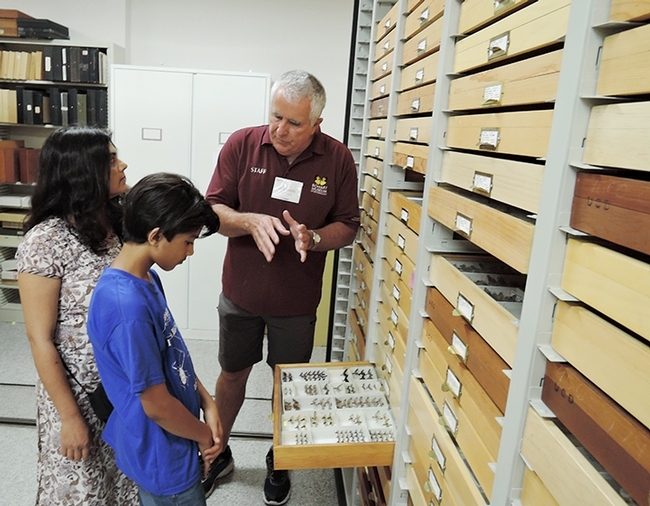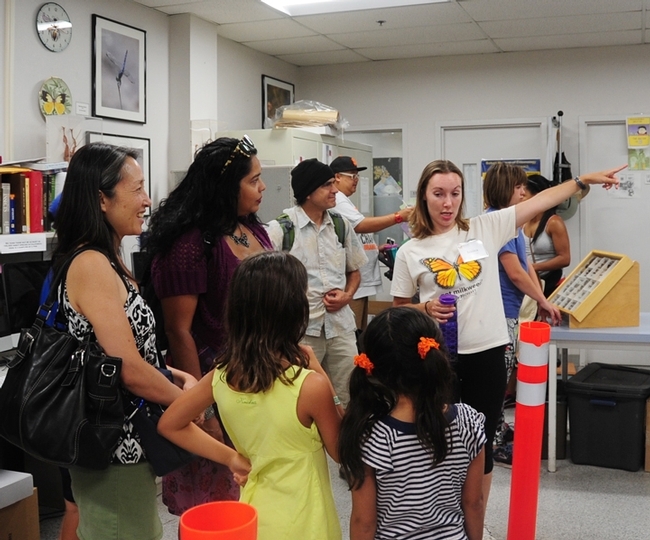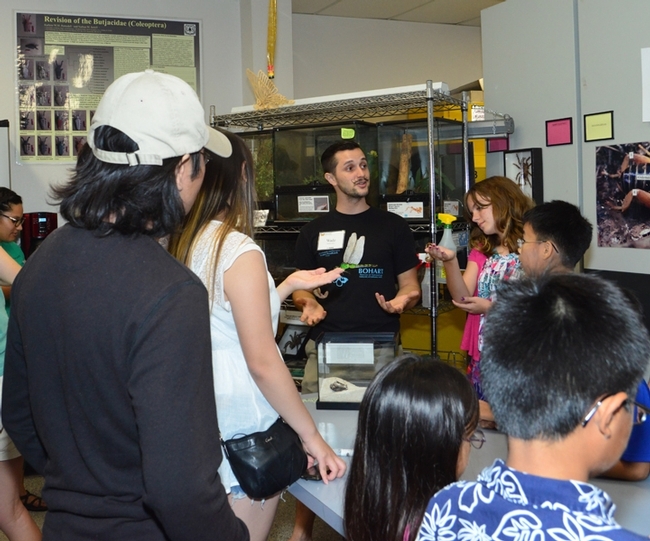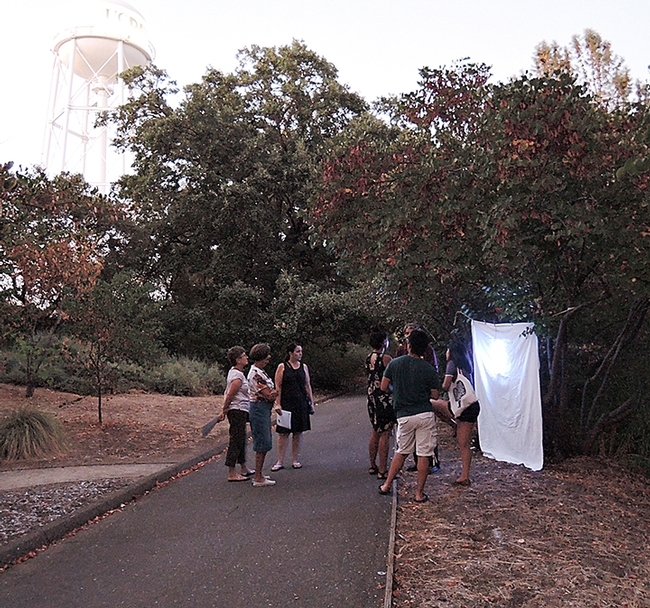- Author: Kathy Keatley Garvey
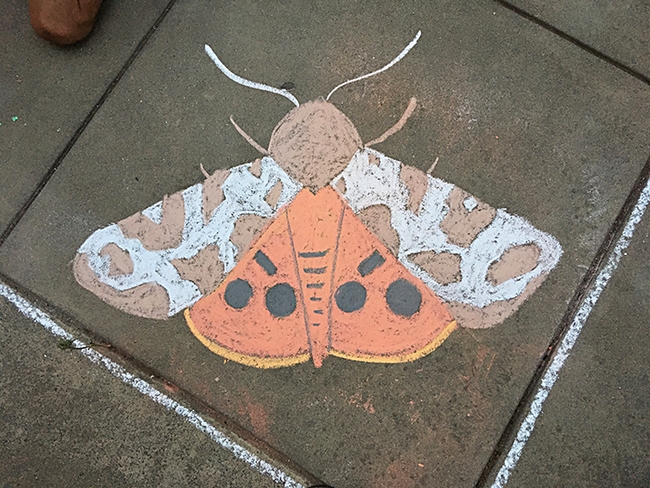
It was like a moth to a flame--or 400 moths to a flame--when a record crowd surged into the Bohart Museum of Entomology Moth Night for its July 30th open house.
After a two-year hiatus due to the COVID pandemic, "how great it was to have the doors open again for the public," said entomologist Jeff Smith, curator of the lepidoptera collection.
The 400-member crowd, thought to be the largest crowd at the Bohart, other than at UC Davis Picnic Day, was there to learn more about moths, draw images of moths on the sidewalks, enjoy an evening of camaraderie, and head outside to watch moths and other insects fly onto the hanging white sheet, part of the blacklighting demonstration display.
“People could draw whatever they wanted on chalk (outside the Academic Surge Building), but there were a lot of moths, although my kids went rogue and drew a soccer field and a figure,” said Tabatha Yang, the Bohart Museum education and outreach coordinator.
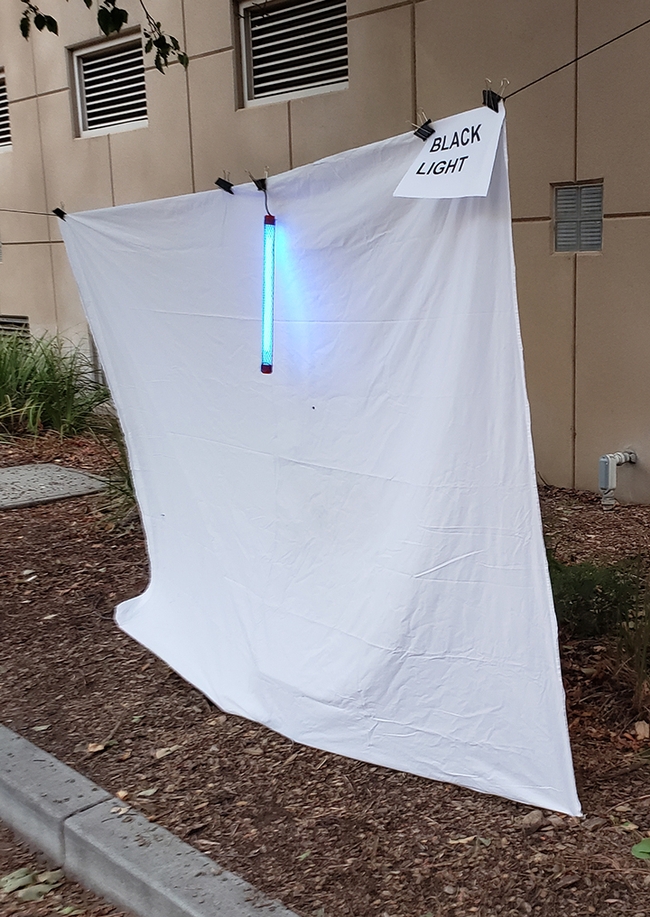
“We ran out of hot water, for the hot cocoa packets, and cookies half-way through!" Yand said, quipping "I thought we would be eating left over chocolate chip cookies at the Bohart all week, but alas that is not the case.”
The blacklighting display (white hanging sheet, ultraviolet light, and a generator) served as a demonstration site. "We had a few small beetles and a few small moths come in," Yang said.
The open house, which drew visitors from as far away as Alameda, took place the weekend before UC Davis summer sessions, so “the popularity among the college set was perhaps because of that, she said. "People were free from studying their required courses and so, on their own, they decided to seek out and learn about moths!”
Kareofelas fielded scores of questions about the Polyphemus moth, Antheraea polyphemus. “They are currently making their appearance in Davis, so a number of folks have seen them and had photos on their phones," he said. "A number of folks came with the desire to see a specific moth, and if we were lucky, it was located in the aisle we had open. Jeff (Smith) had pulled the drawers, from other aisles, with a number of specific species and had them labeled--a lot of questions about these drawers.”
"Some wanted to see the hummingbird moth, so I got to show Hyles lineata to a number of folks," Kareofelas said. "We had a lot of just plain 'good ol' interest' in seeing something and learning something about moths. The night started with a bang and went right to 11:00, still busy!"

"I was surprised at how popular the event was, how busy the store was, and how many folks showed up," Kareofelas said. "It was a great night!"
Smith spent the entire open house demonstrating how to spread the wings of moths. “I couldn't believe how many people came, and I was never ABLE to leave the table where I was demonstrating spreading," Smith said. "There was a constant group of people watching and asking questions, such as 'How did you become interested in this?' and of course, lots of questions on the spreading materials and techniques."
“The moment the door officially opened at 8 p.m., groups came in and headed in all different directions," Smith said. "One couple from Dixon was there with a group of scouts and they must have hung around my demo for 45 minutes with all kinds of interest and questions. People showed me photos on their cell phones of the white-lined sphinx moth, the ceanothus silk moth, and even a buck moth (Hemileuca) from Mono Basin."
Smith said he allowed "at least 10 different young people try their own hand at spreading a moth or two and that was really well received. I had a ziplock bag of surplus, papered moths and let some of the people take some for themselves. When it finally slowed a bit, I finally got up and couldn't believe it was already past 11 p.m." He headed over to the moth aisle where Kareofelas was still showing and answering questions about moths. "Greg did an amazing job. And, I ended up talking to a couple who work on campus until nearly 11:30."
Outside, the crowd marveled at the chalk drawings, including the tiger moths created by Srdan Tunic of UC Davis, a second-year master's degree student in art history. Skilled in street art and in academics (his Linked In profile indicates "Curating: creating bridges between art and people, ideas and objects"), Tunic is the co-founder, researcher and guide of Street Art Walks Belgrade, where he conducts lectures and tours on street art, graffiti, and the history of Belgrade. He holds a bachelor of arts degree (2008) in art history from the University of Belgrade, Serbia, and a master of arts in cultural policy and management (2017) from the University of Arts, Belgrade. He expects to receive his master's degree in art history from UC Davis in May of 2023.
The Bohart Museum, located in Room 1124 of the Academic Surge Building, 455 Crocker Lane, UC Davis campus, and directed by UC Davis distinguished professor Lynn Kimsey, houses a global collection of more than eight million insect specimens. It also houses a live "petting zoo" (Madagascar hissing cockroaches, stick insects and tarantulas) and an insect-themed gift shop. The latest t-shirt features a Jerusalem cricket, aka potato bug.
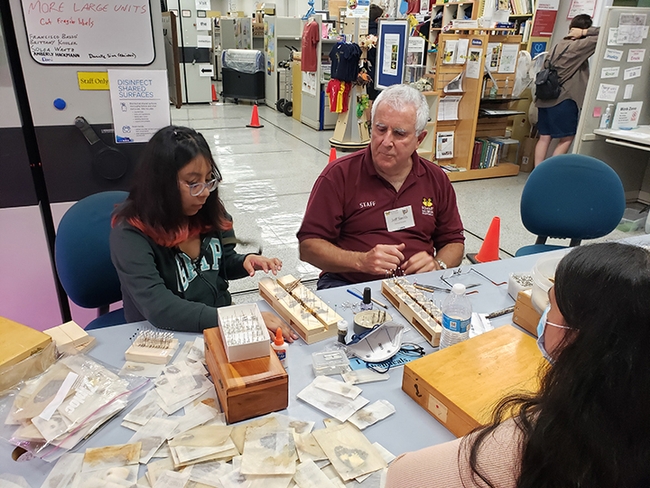
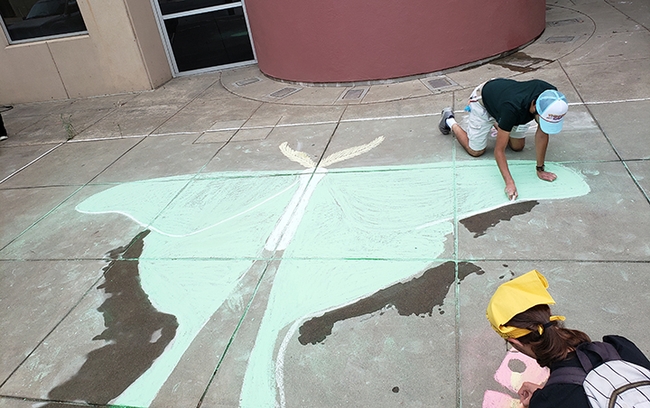
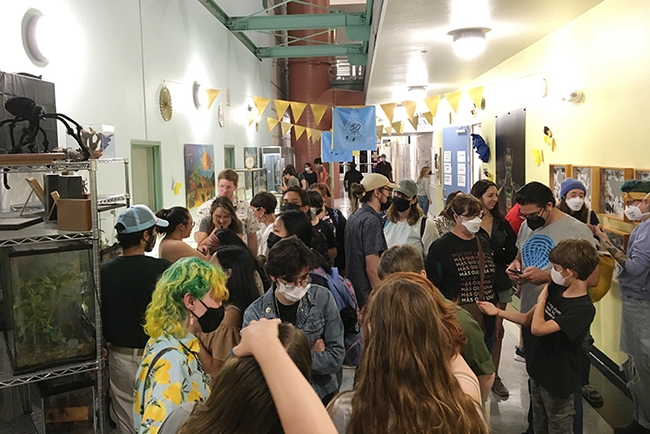
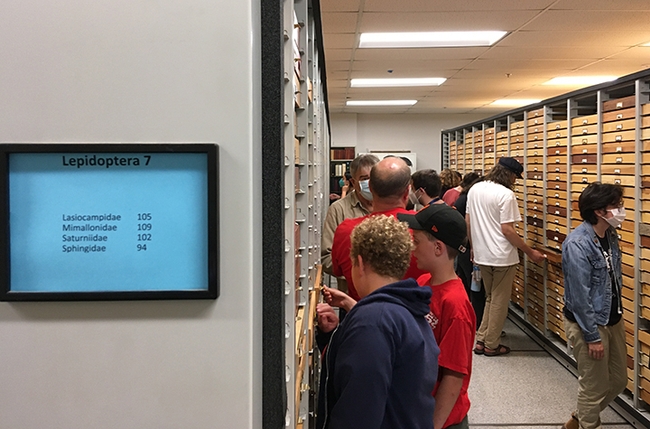
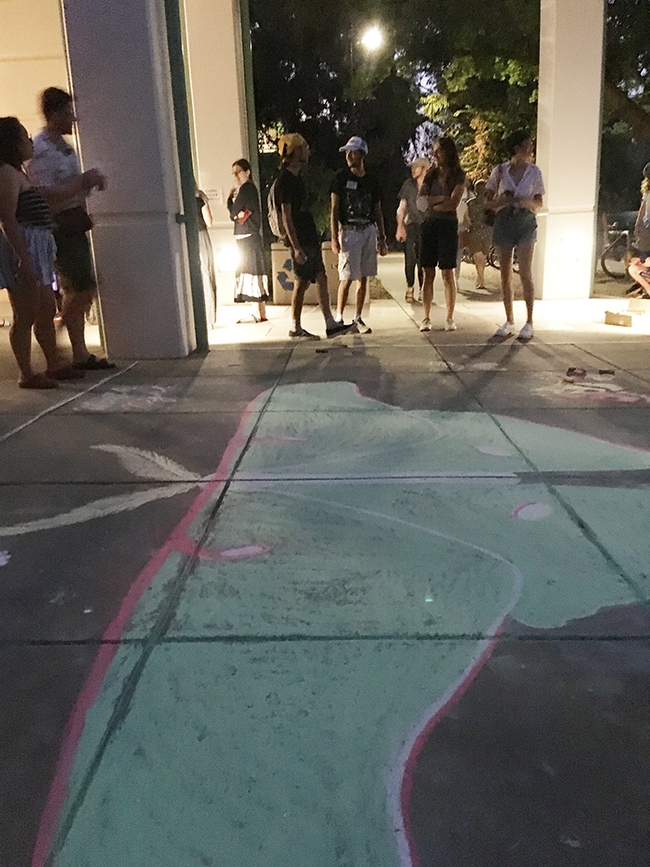
- Author: Kathy Keatley Garvey
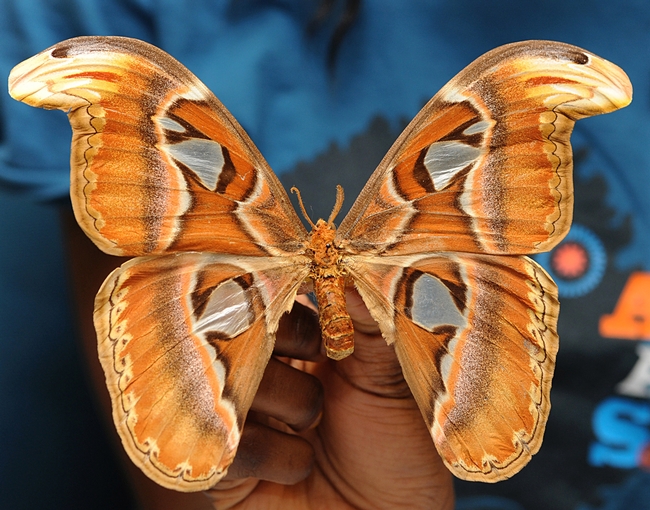
After a two-year hiatus due toCOVID, it's back by popular demand, said Tabatha Yang, education and outreach coordinator for the Bohart Museum.
It's free, family friendly and open to the public. Inside, visitors will see the Bohart's special moth collection, and outside, visitors will see moths and other insects land on the hanging white sheet of the blacklighting display, comprised of an ultraviolet (UV) light, and a generator.
The Bohart collection includes the Atlas moth, Attacus atlas, the world's largest moth with the greatest wing area of 10 to 12 inches. The Atlas is found in the tropical and subtropical forests of Southeast Asia.
Another large moth on display will be the "bat moth" or "black witch" (Ascalapha odorata), found in Central America, South America, Bahamas and parts of the southwestern United States. In Mexican and Caribbean folklore, it is considered a harbinger of death. The insect played a role in the movie, "Silence of the Lambs" but the name was changed to "Death's-head Hawkmoth."
Folks are invited to bring photos or moth specimens from their house, yard or neighborhood that they would like help in identifying, Yang said.
There will also be a craft activity, cookies, and "hot cocoa for anyone who needs help staying up past their bedtime," Yang quipped.
Back in 2019, before the COVID pandemic, the blacklighting display drew at least 11 different species from five moth families: Tineidae, Tortricidae, Pyralidae, Geometridae, and Noctuidae, according to Bohart associate and "Moth Man" John De Benedictis.
The families represented:
Family Tineidae:
Opogona omoscopa (Opogona crown borer)
Family Tortricidae:
Clepsis peritana
Platynota stultana (omnivorous leafroller)
Cydia latiferreana (filbertworm)
Family Pyralidae:
Achyra rantalis (garden webworm)
Ephestiodes gilvescentella (dusky raisin moth)
Cadra figuliella
Family Geometridae:
Digrammia muscariata
Family Noctuidae:
Spodoptera exigua (beet armyworm)
Spodoptera praefica (western yellow-striped armyworm)
Parabagrotis formais
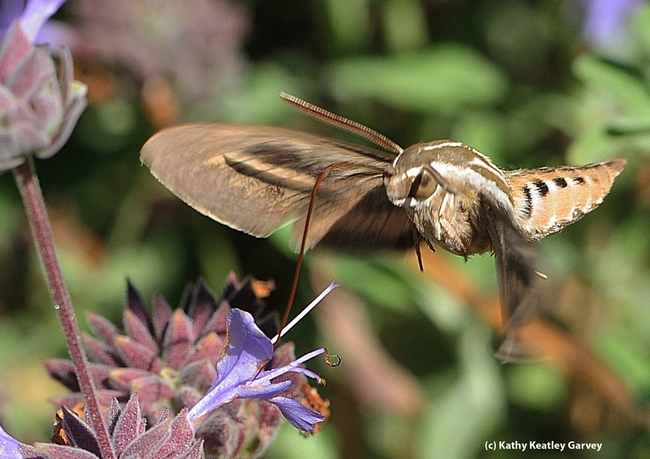
Moth Night (NMW) "celebrates the beauty, life cycles, and habitats of moths, according to the national website. “Moth-ers of all ages and abilities are encouraged to learn about, observe, and document moths in their backyards, parks, and neighborhoods."
NMW, also celebrated worldwide, is traditionally held a week in July. "NMW offers everyone, everywhere a unique opportunity to become a citizen scientist and contribute scientific data about moths," the website relates. "Through partnerships with major online biological data depositories, NMW participants can help map moth distribution and provide needed information on other life history aspects around the globe."
NMW scientists point out:
- Moths are among the most diverse and successful organisms on earth.
- Estimates show that moth species number anywhere from 150,000 to more than 500,000.
- Their colors and patterns are either dazzling or so cryptic that they define camouflage. Shapes and sizes span the gamut from as small as a pinhead to as large as an adult's hand.
- Most moths are nocturnal, and need to be sought at night to be seen--others fly like butterflies during the day.
- Finding moths can be as simple as leaving a porch light on and checking it after dark. Serious moth aficionados use special lights and baits to attract them.
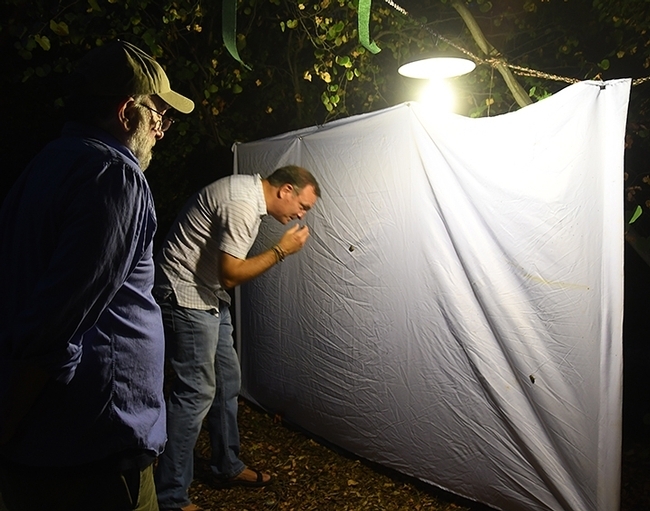
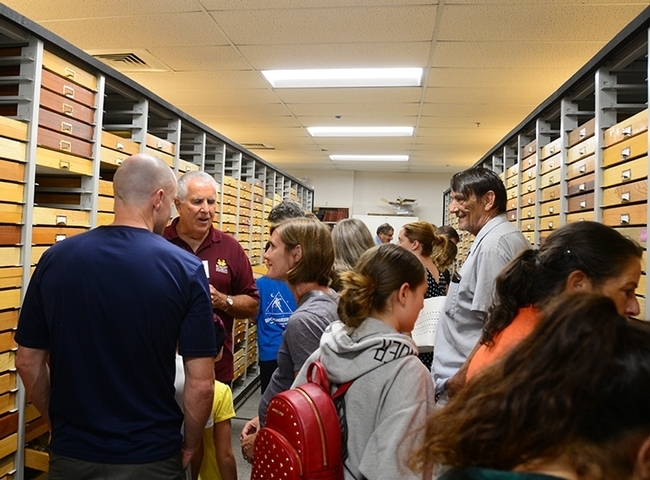

- Author: Kathy Keatley Garvey
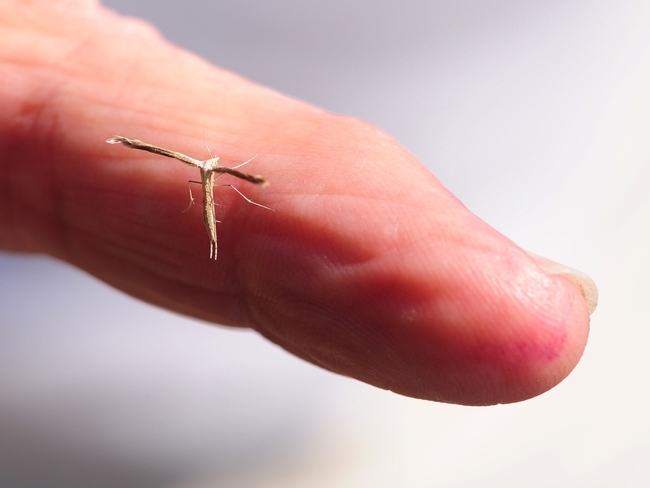
The Bohart Museum of Entomology will host its annual Moth Night--free and family friendly--from 8 p.m. to 11 p.m. on Saturday, Aug. 3. The event takes place the week following National Moth Week, July 20-28.
Blacklighting will take place just outside the museum, located in Room 1124 of the Academic Surge Building, 455 Crocker Lane. For blacklighting, the Bohart scientists use a hanging white sheet that's illuminated by ultraviolet (UV) light and powered by a generator. Throughout the evening, visitors can see what insects are attracted to the white sheets.
Several scientists will be on hand to discuss moths and answer questions. They include senior museum scientist SteveHeydon of theBohart Museum; Jeff Smith, curator of the the moth and butterfly specimens; andBohart associates "Moth Man" John DeBenedictis and GregKareofelas. The best time to see the moths in the light traps is later in the evening, closer to 9:30 or 10, according to LynnKimsey, director of the museum, andTabatha Yang, education and outreach coordinator. Indoor activities--checking out the displays and participating in the craft activity--are planned prior to theblacklighting.Bohart associate Emma Cluff curated a hallway display featuring silkworm moths and silk that links entomology and culture. The silkworm moths are from the Bohart museum collection, and the silk cloth has been donated by silkworm moth authority Richard Peigler, a biology professor at the University of the Incarnate Word, San Antonio, Texas. "He sent us a collection of more than 10 pieces of cloth and several pieces of jewelry that utilize cocoons," Cluff said. "He has sent similar collections of cloth to other research institutions."
"These textiles represent work that has been done for centuries, and in some cases millennia, throughout Asia," Cluff said. "The relationship between these artists and the insects that provide their materials is beautiful and elaborate and we wanted to bring it to light."
The free family craft activity will involve creating silk moth cocoon necklaces. "Kids will be able to color and string white cocoons and make necklaces or bracelets with them," Cluff said.
Free refreshments--hot chocolate and cookies-- will be served.
Last year more than 140 spectators attended Moth Night. The first insects to show up were the scarab beetles or "June bugs" (referring to certain species of scarabs). Beetle expert Fran Keller, assistant professor at Folsom Lake College who received her doctorate in entomology from UC Davis, identified the first scarab beetle to arrive as a Polyphylla sp. or lined June beetle.
Bohart associate and "Moth Man" John De Benedictis listed the species sighted at Moth Night by family. Among them:
- NOCTUIDAE: Spodoptera exigua (Beet Armyworm Moth), Proxenus sp. (probably P. mindara)
- GEOMETRIDAE: Prochoerodes truxaliata
- PYRALIDAE: Ehestiodes gilvescentella
- TORTRICIDAE: Cydia latiferreana (Filbertworm Moth), Grapholita prunivora (Lesser Appleworm Moth)
- GELECHIIDAE: Leucogniella sp. (probably L. distincta)
- TINEDAE: Oinophila v-flava
- ACROLOPHIDAE: Amydria sp. (cannot tell genus or species without dissecting. Likely Pseudopsalta confusella.)
DeBenedictis said a young girl collected the Prochoerodes truxaliata, a moth that feeds on coyote bush as a caterpillar.
Some facts about moths, from the National Moth Week website:Why moths?
- Moths are among the most diverse and successful organisms on earth.
- Scientists estimate there are 150,000 to more than 500,000 moth species.
- Their colors and patterns are either dazzling or so cryptic that they define camouflage. Shapes and sizes span the gamut from as small as a pinhead to as large as an adult's hand.
- Most moths are nocturnal--others fly like butterflies during the day.
- Finding moths can be as simple as leaving a porch light on and checking it after dark. Serious moth aficionados use special lights and baits to attract them.
The Bohart Museum houses a global collection of nearly eight million specimens. It is also the home of the seventh largest insect collection in North America, and the California Insect Survey, a storehouse of the insect biodiversity. Noted entomologist Richard M. Bohart (1913-2007) founded the museum. It maintains a live "petting zoo," featuring Madagascar hissing cockroaches, walking sticks, tarantulas, and praying mantids. The museum's gift shop, open year around, includes T-shirts, sweatshirts, books, jewelry, posters, insect-collecting equipment and insect-themed candy.
The Bohart Museum's regular hours have changed for the summer season. As of July 3, the Bohart is hosting 30-minute tours starting at 2:30 and 3:30 pm. No reservations are required and all ages are welcome. Admission is free, but donations are always welcomed. The Bohart is open to walk-in visitors Monday through Thursday from 1 to 5 p.m. It is closed from 9 a.m. to noon to walk-in visits (the insect museum conducts many tours and outreach programs during those times).
More information on the Bohart Museum is available on the website or by contacting (530) 752-0493 or email bmuseum@ucdavis.edu.
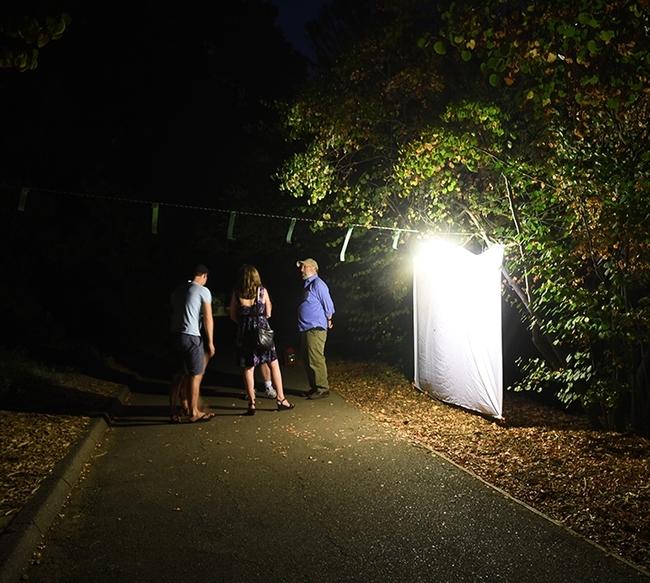
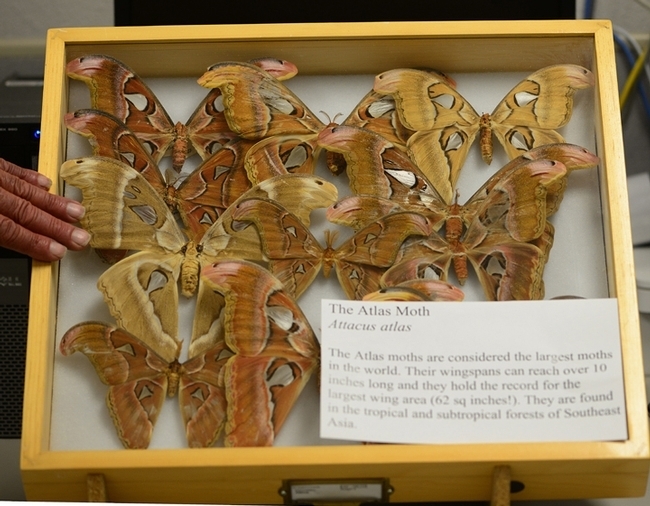
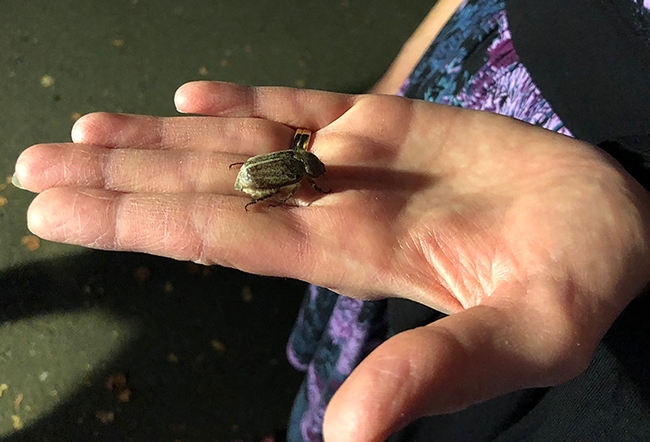
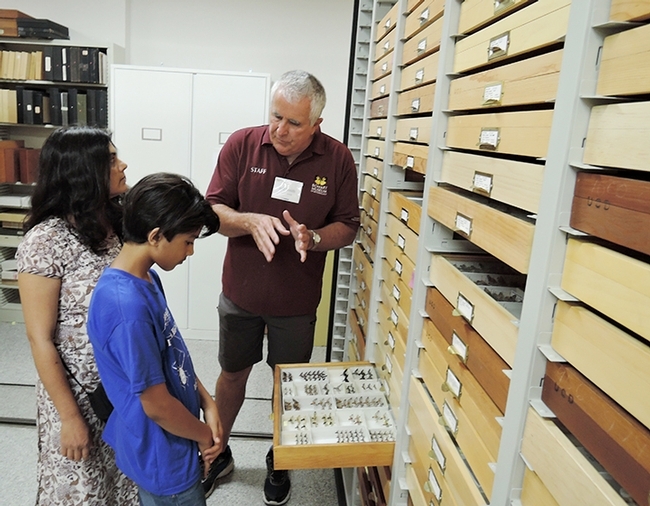
- Author: Kathy Keatley Garvey

Those are a few of the activities or calendar items newly announced by the Bohart Museum of Entomology.
Moth Night. The Bohart will celebrate National Moth Night: Exploring Night Time Nature on Saturday, Aug. 3, instead of in July. The event, free and family friendly, will take place from 8 to 11 p.m. Visitors can view the Bohart's world-class collection of moths, make a craft, and search for moths outside with experts. Scientists will set up a blacklight to draw night-flying insects. The set-up includes a white sheet that's illuminated by a generator-powered ultraviolet (UV) light.
Last year Bohart associate and "Moth Man" John De Benedictis listed the species, by family, sighted at Moth Night. Among them
- NOCTUIDAE: Spodoptera exigua (Beet Armyworm Moth), Proxenus sp. (probably P. mindara)
- GEOMETRIDAE: Prochoerodestruxaliata
- PYRALIDAE: Ehestiodesgilvescentella
- TORTRICIDAE: Cydia latiferreana (Filbertworm Moth), Grapholita prunivora (Lesser Appleworm Moth)
- GELECHIIDAE: Leucogniella sp. (probably L. distincta)
- TINEDAE: Oinophila v-flava
- ACROLOPHIDAE: Amydria sp. (cannot tell genus or species without dissecting. Likely Pseudopsalta confusella.)
Lepidopterists' Society Meeting. The Bohart Museum will be closed to the public July 8-12 to accommodate the 68th annual meeting of the Lepidopterists' Society. The Bohart Museum, to host the conference, maintains the seventh largest insect collection in North America with more than eight million specimens. It is also the home of the California Insect Survey.
New Summer Hours. The Bohart Museum will be closed in the mornings to walk-in visitors due to scheduled tours and outreach events, announced Tabatha Yang, education and outreach coordinator. The insect museum will be open to visitors from 1 to 5 p.m., Mondays through Thursdays "and we are offering a scavenger hunt."
Wednesday Walk-Ins. "On Wednesdays, starting July 3 at 2:30 p.m. and 3:30 p.m., we will have casual 30-minute tours for walk-in visitors," Yang said. "No reservations are required. All of these events are free to the public, but donations are suggested."
Directed by Lynn Kimsey, UC Davis professor of entomology, the insect museum is located in Room 1124 of the Academic Surge Building on Crocker Lane. The Bohart also houses a gift shop and a live "petting zoo," comprised of Madagascar hissing cockroaches, walking sticks and tarantulas.
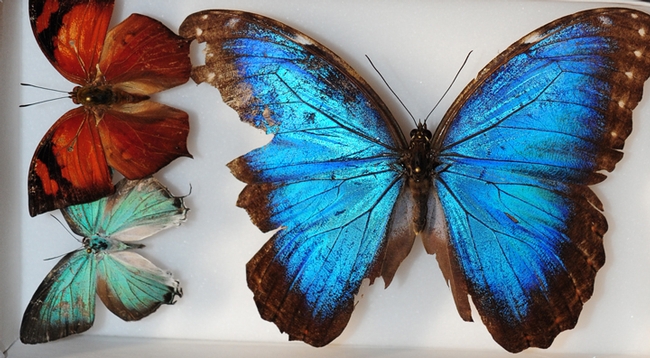
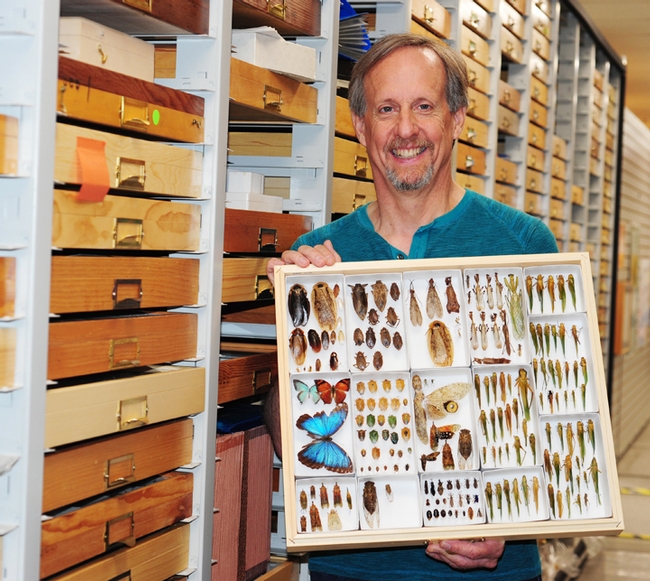
- Author: Kathy Keatley Garvey
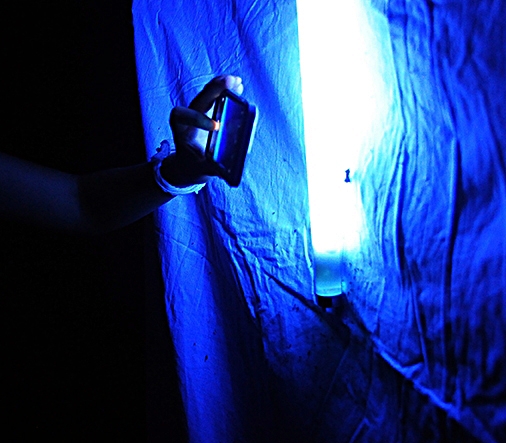
The Bohart Museum of Entomology, located in Room 1124 of the Academic Surge Building, Crocker Lane, UC Davis campus, is hosting a "Moth Night" from 8 p.m. to 11 p.m. on Saturday, July 21. Free and open to the public, this is a "family friendly event all about moths," according to Lynn Kimsey, director of the Bohart Museum and Tabatha Yang, education and outreach coordinator. Events will take place both inside and outside the insect museum.
The Bohart Museum Moth Night is being held in conjunction with National Moth Week, July 21-29, which celebrates the beauty, life cycles and habitats of moths. The UC Davis event is one of only two public events scheduled in California during the week; the other is in San Mateo County on July 28.
Bohart scientists will be on hand to discuss moths and answer questions. They include three Bohart associates: entomologist Jeff Smith of Rocklin, curator of the the moth and butterfly specimens; and "Moth Man" John DeBenedictis and naturalist and photographer Greg Kareofelas, both of Davis, who will staff the light traps/blacklighting displays. The best time to see the moths in the light traps is later in the evening, closer to 10.
"We will focus on colorful moths of the night--night rainbows if you will and the biodiversity of tropical moths," Yang said. A family craft activity is planned. Last year the family craft activity featured making moth-shaped window ornaments resembling stained glass.
Free refreshments--cookies and hot chocolate--will be served. Common Grounds, a Davis coffee shop. will be providing the large containers of hot water for the event.
Last year more than 15 species landed on the blacklighting display. The first moth to arrive was the alfalfa looper moth, Trichopusia ni. The most striking: the grape leaffolder, Desmia funeralis.
Some facts about moths, from the National Moth Week website:
Why moths?
- Moths are among the most diverse and successful organisms on earth.
- Scientists estimate there are 150,000 to more than 500,000 moth species.
- Their colors and patterns are either dazzling or so cryptic that they define camouflage. Shapes and sizes span the gamut from as small as a pinhead to as large as an adult's hand.
- Most moths are nocturnal, and need to be sought at night to be seen--others fly like butterflies during the day.
- Finding moths can be as simple as leaving a porch light on and checking it after dark. Serious moth aficionados use special lights and baits to attract them.
The Bohart Museum houses a global collection of nearly eight million specimens. It is also the home of the seventh largest insect collection in North America, and the California Insect Survey, a storehouse of the insect biodiversity. Noted entomologist Richard M. Bohart (1913-2007) founded the museum. It maintains a live "petting zoo," featuring Madagascar hissing cockroaches, walking sticks, tarantulas, and praying mantids. The museum's gift shop, open year around, includes T-shirts, sweatshirts, books, jewelry, posters, insect-collecting equipment and insect-themed candy.
The Bohart Museum's regular hours are from 9 a.m. to noon and 1 to 5 p.m. Mondays through Thursdays. It is closed to the public on Fridays, Saturdays and Sundays and on major holidays. Admission is free.
More information on the Bohart Museum is available on the website or by contacting (530) 752-0493 or email bmuseum@ucdavis.edu.
